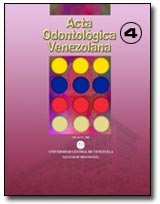TRATAMIENTO RESTAURADOR ATRAUMÁTICO COMO UNA HERRAMIENTA DE LA ODONTOLOGÍA SIMPLIFICADA. REVISIÓN BIBLIOGRÁFICA
Palabras clave:
Tratamiento restaurador atraumático, cemento de vidrio ionomérico, caries, Atraumatic restorative treatment, glass ionomer cement, dental cariesResumen
El tratamiento restaurador atraumático (ART) constituye una nueva visión de la odontología, fue creado en la década de los 80 en Tanzania. Esta técnica se diseñó con la finalidad de atender las necesidades de salud bucal de los pacientes más desposeídos y aquellos que viven en zonas remotas en donde no existen equipos sofisticados, servicios de electricidad, ni agua potable. Estos tratamientos consisten en eliminar la menor cantidad de tejido dental, empleando instrumentos manuales, cemento de vidrio ionomérico como material de obturación, sin la necesidad de equipos odontológicos ya que cualquier espacio y mueble en donde un paciente se pueda acostar le permitirá a este recibir el tratamiento. Un aspecto clave de la técnica consiste en orientar al paciente en métodos profilácticos y hábitos nutricionales que propicien un cambio en la flora bacteriana de la cavidad bucal, impidiendo la proliferación de agentes patógenos causantes de la caries dental. Es una técnica sencilla que puede ser ejecutada por personal asistente, bajo la supervisión del odontólogo, lo cual permite tener una mayor cobertura en la población, adicionalmente es poco costosa. El propósito de esta revisión bibliográfica es informar brevemente el protocolo a seguir para emplear la técnica de los tratamientos restauradores atraumáticos, sus ventajas y desventajas.
Abstract
The atraumatic restorative treatment constitutes a new vision of the dentistry, was created in the decade of the 80 in Tanzania. This technique design with the purpose of taking care of the necessities of oral health of the patients more destitute and those than lives in remote zones in where the sophisticated equipment does not exist, nor the services of electricity, potable water, etc. These treatments consist of eliminating the smaller amount of dental tissue, using manual instruments, glass ionomer cement like obturating material, without the necessity of dental equipment since any space and furniture in where a patient can be laid down will allow this receiving the treatment. A key aspect of the technique consists of orienting to the patient in prophylactic methods and nutritional habits that cause a change in the bacterium flora of the buccal cavity, preventing the proliferation of pathogenic agents causes of the dental caries. It is a simple technique that can be executed by attending personnel, under the supervision of the dentist, which allows to have a greater cover in the population, additionally is little expensive. The intention of this review is to inform briefly the suggested protocol in the use of this technique.

